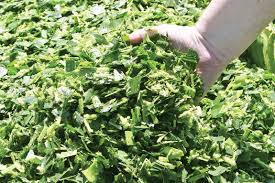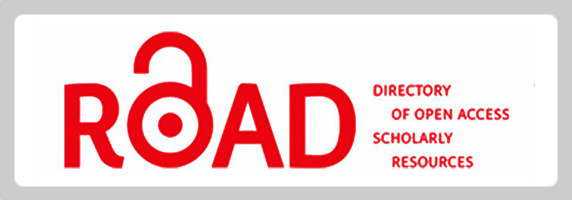Effect of Energy, Protein and Microbial Inoculants Additives on Chemical Composition and Fermentation Characteristics of Corn Stover Silage
Abstract
Corn stover was taken after harvesting the ears immediately, chopped using a harvester chopper machine to 1.5-2.0 cm of length, and supplemented with energy additive (corn grains and molasses), protein additive (soybean, urea, and opting) and microbial inoculants (effective microorganisms EM1) and their interactions and ensiled in plastic bags for 45 days. After the ensiling period, representative samples were taken for the determination of chemical composition and silage quality traits. Adding ground corn grains to corn stover silage led to a significant (P<0.05) increase in DM content. Moreover, NFE content of corn stover silage increased significantly (P<0.05), however, ash content decreased significantly (P<0.05) with molasses and ground corn grains supplementation. Soybean meal supplementation increased significantly (P<0.05) DM content than those of urea and optigen supplementation with insignificant differences with control. The crude protein content of corn stover silage increased significantly (P<0.05) with soybean meal, urea, and Optigen supplementation. Ash content decreased significantly (P<0.05) with soybean meal supplementation. Effective microbes supplementation led to a significant (P<0.05) increase in the contents of CP and NFE of corn stover silage and a significant (P<0.05) decrease in the contents of CF and ash. The interaction between energy and protein supplementation showed a significant difference (P<0.05) in DM content only. Interactions among energy, protein, and effective microbes supplementation showed significant difference (P<0.05) in DM content only. The pH value of the silage decreased significantly (P<0.05), however lactic acid concentration increased significantly (P<0.05) with molasses and ground corn grains supplementation. The pH value of silage was higher significantly (P<0.05) with urea and Optigen compared to control and soybean supplementation. Urea-supplemented silage recorded significantly (P<0.05) the NH3-N concentration followed by Optigen, then soybean meal, whoever control had the lowest concentration. Moreover, soybean meal-supplemented silage showed significantly (P<0.05) higher concentrations of TVFAs and lactic acid compared to urea-supplemented silage. The concentrations of NH3-N and lactic acid increased significantly (P<0.05) with effective microbes supplement to corn stover silage. Energy and protein supplementation interaction revealed that urea with molasses or ground corn grains recorded significantly (P<0.05) higher pH values and NH3-H concentration of silage compared to soybean with molasses or ground corn grains. However, soybean meal with molasses or ground corn grains recorded significantly (P<0.05) higher concentrations of TVFA’s and lactic acid in silage compared to urea with molasses or ground corn grains. The interaction between protein and effective microbes showed that urea with EM1 supplemented silage had significantly (P<0.05) higher pH value and NH3-N concentration and lower TVFA’s and lactic acid concentrations than those of soybean meal with EM1. The interaction among energy, protein, and effective microbes showed that molasses or ground corn grains with urea plus EM1 supplemented silages had significantly (P<0.05) higher pH value and NH3-N concentration and lower TVFA’s and lactic acid concentrations than those of molasses or ground corn grains with soybean meal plus EM1. The pH value of the silage decreased significantly (P<0.05), however lactic acid concentration increased significantly (P<0.05) with molasses and ground corn grains supplementation. The pH value of silage was higher significantly (P<0.05) with urea and Optigen compared to control and soybean supplementation. Urea-supplemented silage recorded significantly (P<0.05) the NH3-N concentration followed by Optigen, then soybean meal, whoever control had the lowest concentration. Moreover, soybean meal-supplemented silage showed significantly (P<0.05) higher concentrations of TVFA’s and lactic acid compared to urea-supplemented silage. The concentrations of NH3-N and lactic acid increased significantly (P<0.05) with effective microbes supplement to corn stover silage. Energy and protein supplementation interaction revealed that urea with molasses or ground corn grains recorded significantly (P<0.05) higher pH values and NH3-H concentration of silage compared to soybean with molasses or ground corn grains. However, soybean meal with molasses or ground corn grains recorded significantly (P<0.05) higher concentrations of TVFA’s and lactic acid in silage compared to urea with molasses or ground corn grains. The interaction between protein and effective microbes showed that urea with EM1 supplemented silage had significantly (P<0.05) higher pH value and NH3-N concentration and lower TVFA’s and lactic acid concentrations than those of soybean meal with EM1. The interaction among energy, protein and effective microbes showed that molasses or ground corn grains with urea plus EM1 supplemented silages had significantly (P<0.05) higher pH value and NH3-N concentration and lower TVFA’s and lactic acid concentrations than those of molasses or ground corn grains with soybean meal plus EM1.
Downloads
References
Allman, J.G. and L.A. Stern (1999). BiomaxÒ5 Microbial Inoculant for Corn Silage.
Analytical Chemistry of foods (1995). Published by Blockie academic and professional, an imprint of chapman & Hall, western cleddens Road, Bishopbriggs, Glasgow G64 2NZ, UK.
AOAC (1990).Official methods of analysis of the Association of Official Analytical Chemists. 2 vols. 15th ed. Washington, DC, USA.
Bilal, M.Q. (2009). Effect of molasses and corn as silage additives on the characteristics of mott dwarf elephant grass silage at different fermentation periods. Pakistan Vet. J., 29(1): 19-23.
Boin, C. (1975). Elephant (Napier) Grass Silage Production Effect of Additives on Chemical Composition, Nutritive Value and Animal Performance. Ph.D. Thesis, Cornell University, Ithaca, p. 215.
Bolsen, K.K. (1999). Silage Management in North America in the 1990s. In: Lyons, T.P. and Jacques, K.A., Eds., Biotechnology in the Feed Industry, Proceedings of the 15th Annual Symposium, Nottingham University Press, Nottingham, 233-244.
Bolsen, K.K.; D.R.Bonilla; G.L.Huck; M.A.Young; R.A.Hart-Thakur and A.Joyeaux (1996). Effect of a propionic acid bacterial inoculant on fermentation and aerobic stability of whole-plant corn silage. Journal of Animal Science, 74: 274.
Caro, D., S.J. Davis; E. Kebreab and F. Mitloehner (2018). Land-use change emissions from soybean feed embodied in Brazilian pork and poultry meat. Journal of cleaner production, 172: 2646-2654.
Dalgaard, R.; J. Schmidt; N. Halberg; P. Christensen; M. Thrane and W.A. Pengue (2008). LCA of soybean meal. The International Journal of Life Cycle Assessment, 13(3): 240.
Dawson, T.E. (1994). Propionic acid-producing bacteria as bioinoculants for the preservation of ensiled high-moisture corn. Ph.D. Dissertation, Michigan State University, East Lansing.
Dreihuis, F.; S.F.Spoelstra; S.C.J. Cole and R.Morgan (1996). Improving Aerobic Stability by Inoculation with Lactobacillusbuchneri. Proceedings of the 11th International Silage Conference, Aberystwyth, 8-11 September 1996, 106-107.
FAO. (2012). States of the World’s Forests. Food and Agriculture Organisation of the United Nations.
FAO. (2017). Formation of the Technical Advisory Group on feed additive environmental assessment.
Flores-Galaraza, R.O.; B.A.Glatz; C.J. Bernand L.D. Van Fossen (1985). Preservation of high moisture corn by microbial fermentation. Journal of Food Protection, 48: 407-411.
Gerber, P.J.; H. Steinfeld; B. Henderson; A. Mottet; C. Opio; J. Dijkman; A. Falcucci and G. Tempio (2013). Tackling climate change through livestock: a global assessment of emissions and mitigation opportunities. Food and Agriculture Organization of the United Nations (FAO).
Glewen, M.J. and A.W. Young (1982). Effect of Ammoniation on the Refermentation of Corn Silage. Journal of Animal Sciences, 54:713-718.
Haigh, P.M. (1988). The effect of wilting and silage additives on the fermentation of Autmn made grass silage ensiled in bunkers on commercial farms in South Wales. Grass and Forage Science, 43: 337-345.
Henderson, N. (1993). Silage Additives. Animal Feed Science and Technology, 45, 35-56.
IBM SPSS Statistics (2020). Statistical Package for the Social Science. Release 27. SPSS, Inc., Chicago, Illinois, USA.
Kazer, J. and J. Madoc-Jones (2019). Alltech Optigen® Carbon Trust Validation Report. In confidence and not for external publication. Carbon Trust Advisory Limited.
Keady, T.W.J. (1996). A Review of the Effects of Molasses Treatment of Unwilted Grass at Ensiling on Silage Fermentation, Digestibility and Intake, and on Animal Performance. Irish Journal of Agricultural and Food Research, 35, 141.
Kertz, A.F. (2010). Review: Urea Feeding to Dairy Cattle: A Historical Perspective and Review. The Professional Animal Scientist, 26(3).
Kung, L., W.M. Craig and L.D.Satter (1989). Ammonia-Treated Alfalfa Silage for Lactating Dairy Cows. Journal of Dairy Science, 72: 2565-2572.
Kung, L.; N.K.Ranjit; J.R.Robinson and R.C.Charley (1999). The Effect of Lactobacillusnbuchneri on the Fermentation and Aerobic Stability of Barley Silage. Proceedings of the 12th International Silage Conference, Uppsala, 5-7 July 1999, p. 272-273.
Lattemae, P.; A.Laats and U.Tamm (2006). The Technological Factors Affecting the Quality of Big Bale Silage. www.eria.ee/public/files/summary_1.8_2006./link.
Lehuger, S.; B. Gabrielle and N. Gagnaire (2009). Environmental impact of the substitution of imported soybean meal with locally-produced rapeseed meal in dairy cow feed. Journal of Cleaner Production, 17(6): 616-624.
McDonald, P.; A.R. Henderson and S.J.E.Heron (1991). The Biochemistry of Silage. 2nd Edition. Chalcombe Publications, Marlow, Bucks.
Merry, R.J.; R.F.Cussen-MacKenna; A.P. Williamsand J.K.S. Tweed (1993). The Effect of Different Inoculants on Fermentation and Proteolysis in Silages of Differing Perennial Ryegrass and White Clover Content. Proceedings of the 10th International silage Conference, Dublin, 6-8 September 1993, p. 83.
Nayigihugu, V.; D.W. Kellogg; Z.B. Johnson; M. Scott and K.S. Anschutz (1995). Effects of adding levels of molasses on composition of bermudagrass (Cynodon dactylon) silage. J. Animal Sc., 73, Suppl.1: 200.
Nursoy, H.; S. Deniz; M. Demirel and N. Denek (2003). The Effect of Urea and Molasses Addition into Corn Harvested at the Milk Stage on Silage Quality and Digestible Nutrient Yield. Turk. J. Vet. Anim. Sci., 27: 93-99.
Ojeda, F. (1993). Conservantesquimicosen la preservacion de ensilajestropicales. Pastos y Forrajes, 16: 193-200.
Oliveira, A.S. (1995). Rapid pH reductions in silages. Vol. 12, RevistaBrasileirade Saúde e Produção Animal, Salvador, 1-5.
Ridla, M. and S.Vehida (1998). Effects of combined treatment of lactic acid bacteria and cell wall degrading enzymes on fermentation and composition of rhodes grass (Chloris gayanaKunth). Asian-Australasian Journal of Animal Sciences, 11: 522-529.
Sariçiçek, B.Z. and U. Kiliç (2009). The Effects of Different Additives on Silage Gas Production, Fermantation Kinetics and Silage Quality. Ozean Journal of Applied Sciences, 2(1).
Singh, A.; J.C. Edward; S. Mor and K. Singh (1996). Effect of Inoculation of Lactic Acid and Additives on Ensiling M.P. Chari (Sorghum Bicolor). Indian Journal of Animal Sciences, 66: 1159-1165.
Tosi, H.; L.R. Rodrigues; A. De; C.C. Jobim; R.L. Oliveira; A.A.M. Sampaio and B. Rosa (1995). Ensilagem do Capim-Elefante cv. Mott sob diferentes tratamentos. Reunião da Sociedade Brasileira de Zootecnia, 24: 909-916.
Vilela, D. (1984). Aditivos na ensilagem. Coronel Pacheco, MG: EMBRAPA-CNPGL, Circular Técnica 21, p. 32.
Warner, A.C.I. (1964). Production of volatile fatty acids in the rumen, methods of measurements. Nutr.Abst. and Rev., 34:339.
Weinberg, Z.G. and G.Ashbell (1993). Biological Silage Additives-Summary of Experiments in Israel. Proceedings of the 10th International Silage Conference, 6-8 September 1993, Dublin, 26.
Weiss, B. and J. Underwood (2009). Silage Additives. Ohio State University Extension Department of Horticulture and Crop Science, Columbus.
Woolford, M.K. (1984). The Silage Fermentation. Marcel Decker, New York.

Copyright (c) 2023 Hamed Mohamed Gaafar, Mohamed Kamel Mohsen, Elsayed Mohamed Abdel-raouf, Wasef Abdel-aziz Riad, and Nadia Ibrahim Hassan

This work is licensed under a Creative Commons Attribution-NonCommercial-NoDerivatives 4.0 International License.










